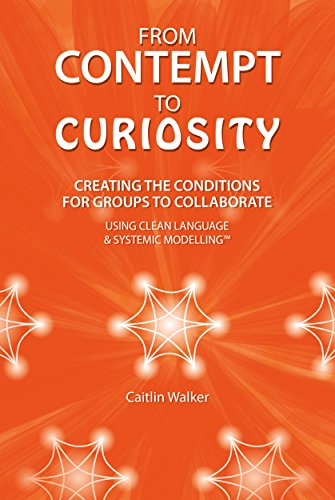“From contempt to curiosity”, C. Walker – the genesis of Systemic Modelling
Mon Mar 26, 2018 - 3 min read
By Gaël Mareau
When one is talking about Clean Language and especially Clean with teams or groups, the time it takes before a reference is made to Caitlin Walker’s work is usually very short (around 10 to 15 seconds according to very serious studies). I’ve heard it mentioned so many times that I could not escape reading “From contempt to curiosity: creating the conditions for groups to collaborate”. Between you and me, I didn’t really force myself. The book combines two of my favorite topics: clean language and group collaboration.
Let’s get down to business if you don’t mind.” From contempt to curiosity” begins with a brief introduction where Caitlin Walker tells a small piece of her personal story and her meeting with David Grove. After that, each chapter covers a stage in the journey that led to the creation of Systemic Modelling. In Chapter 1, we follow Caitlin in her experiments with a group of practices. With the first models and tools in mind, in Chapter 2, she sets out to turn disdain into curiosity among disadvantaged teenagers. Chapter 3 takes us into the corporate world where individuals and teams develop metaphors. The contexts vary in the subsequent chapters: public sector, education, welfare to work company…
Taken individually each chapter contains roughly:
- an explanation of the context
- Caitlin’s reflections on how to carry out her mission extracts from sessions
- explanations of the models used
- feedback on results
The content is therefore rich and gives a very good idea of the functioning and potential of Systemic Modelling. By the way, it is not necessary to know the Clean Language before reading. The whole is pleasant to read and is decorated, as a bonus, with nice illustrations.

There are also warnings at the end of the chapter. I found these passages particularly revealing of the author’s state of mind and somewhere of her honesty. Clean Language and Systemic Modelling are not sold as miracle methods. These warnings are an opportunity to recall that external factors can contribute to the success of the process, that sometimes the changes have not lasted, …
To finish on the form, the 200 pages read quickly and well. There’s no such thing as unnecessary blah-blah. We are far, far away, from some American-style books where the same idea is repeated over and over again on the edge of lobotomy.
In short, I found the book fascinating as much on the content as on the form. Under an apparent simplicity, probably linked to the medium used, Caitlin Walker delivers us a set of powerful tools to create the conditions for collaboration. I found there principles that resonate strongly with my own experiences including, in disorder:
- meet the client where he is
- the impetus for change comes from the client’s system
- believe that the client has what it takes to find their own solutions
- develop the client’s ability to do alone what they have done with the facilitator
- continuous improvement
“From contempt to curiosity” is one of those books, and they are not so many, that I will keep on a shelf at hand both for its practicality and for the reflections it has triggered and will trigger again in the future. Obviously, my point of view is biased by definition since it is a point of view. You don’t have to take my word for it. 😉